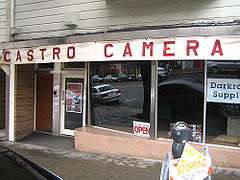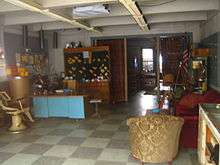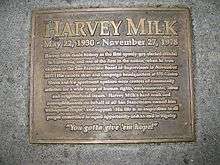Castro Camera
| Castro Camera | |
|---|---|
 Castro Camera storefront, as recreated for the 2008 film Milk | |
| General information | |
| Address | 575 Castro Street |
| Town or city | Castro District, San Francisco, California |
| Country | United States of America |
| Construction started | 1972 |
Castro Camera was a camera store in the Castro District of San Francisco, California, operated by Harvey Milk from 1972 until his assassination in 1978. During the 1970s the store became the center of the neighborhood's growing gay community, as well as campaign headquarters for Milk's various campaigns for elected office.
History

Milk, an avid amateur photographer,[1] was disappointed over a developer ruining a roll of film. With his then-partner, Scott Smith, Milk opened the store in 1972, using the last $1,000 of their savings. The store soon became a focus of the growing influx of young gay people, who were coming from across the US to the Castro, where their sexual orientation was accepted.[2]
Beyond selling cameras and film, Milk turned the store into a social center, and a refuge for new arrivals.[2][3] He also made it an official polling station for San Francisco elections.[4] Because he was so well known for his civic involvement promoting gay businesses and gay consumers, Milk soon became known unofficially as the "Mayor of Castro Street".[2] Daniel Nicoletta, the photographer best known for chronicling Milk and his times, first met Milk as a patron of the store, then later worked there as a store assistant and campaign worker.[1] Another customer, Anne Kronenberg, who later became Milk's campaign manager, also met Milk at the store, and described her first impression of him as a "raving maniac".[5] Other members of Milk's inner circle such as Cleve Jones and his speechwriter Frank Robinson met, befriended, and worked with Milk at the store.[6][7]
Post-closure

The location at 575 Castro Street, a Human Rights Campaign Store as of 2011,[8] was recreated as a set for Milk, the biopic of Milk's life.[9] The sparse set, carefully built to original detail including an old red couch and barber's chair,[10] drew the attention of many local residents who remembered the original.[6] The modern-day shop owner and film crew also described seeing a ghost at the store, whom they assumed to be Milk.[11][12]

A metal plaque set into the sidewalk in front of the store memorializes Milk,[13] and the location has been used as the stepping-off point for an annual memorial march on the date of his death.
Artifacts from Castro Camera, including Milk's barber chair, a collection of antique cameras that was displayed at the store and the front panel of the awning bearing the name of the shop, are preserved in the holdings of the GLBT Historical Society, a museum, archives and research center in San Francisco. The society displayed the camera collection in an exhibition it devoted to Milk in 2003, "Saint Harvey: The Life and Afterlife of a Modern Gay Martyr."[14] In addition, the art director for Milk consulted the collection when creating props for the Castro Camera set.[15]
References
- 1 2 Johnny Ray Huston (2008-11-19). "Hot flash gallery:The Milk Issue: Now and then in the photography of Daniel Nicoletta". San Francisco Bay Guardian.
- 1 2 3 Randy Shilts (1988). The Mayor of Castro Street:the Life and Times of Harvey Milk. Macmillan. ISBN 978-0-312-01900-6.
- ↑ Meredith May (2003-11-27). "From Milk's times to our times:Hard to fathom gay rights gains since 'St. Harvey' fell". San Francisco Chronicle.
- ↑ Heather Smith and Bennett Cohen. "The Harvey Milk effect". San Francisco Magazine.
- ↑ David Lamble (2008-11-20). "Lesbian at the heart of Milk's posse". Bay Area Reporter.
- 1 2 Sharyn Jackson (2008-11-20). "Milking it:In a new biopic, gay-rights activist Cleve Jones sees an icon honored at last". Time Out New York.
- ↑ Andrew Davis (2008-11-20). "Frank Robinson on Harvey Milk". Windy City Times.
- ↑ "Harvey Milk's Shop, Center of a Movement, Is Now the Center of an Internal Fight". NY Times. 2010-12-19.
- ↑ Steven Winn (2008-01-30). "Picturing Harvey Milk:Filming of movie evokes memories, emotions in the Castro". San Francisco Chronicle.
- ↑ Anne Kronenberg. "Everybody Needed Milk". Leyland Publications.
- ↑ "Harvey Milk's ghost stops by film set". 3 News. 2008-11-13.
- ↑ Teeman, Tim (2009-01-17). "Harvey Milk's San Francisco". London: The Times. Retrieved 2010-04-28.
- ↑ Sam Whiting (2000-06-23). "Where History Was Made:A tour of 41 points of gay interest all across the city". San Francisco Chronicle.
- ↑ Delgado, Ray (2003-06-06). "Museum opens downtown with look at 'Saint Harvey'; exhibitions explore history of slain supervisor, rainbow flag". San Francisco Chronicle. Retrieved 2011-07-09.
- ↑ Koskovich, Gérard (2009-03-02). "A quoi sert un centre d'archives? Le film de Gus Van Sant donne une réponse," Yagg.com; consulted 2011-07-15.
External links
- The Gay, Lesbian, Bisexual, Transgender Historical Society holds a collection of Milk's personal belongings, including artifacts from Castro Camera.
Coordinates: 37°45′35″N 122°26′05″W / 37.759786°N 122.43468°W